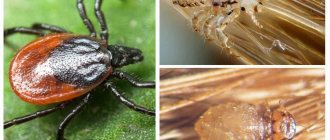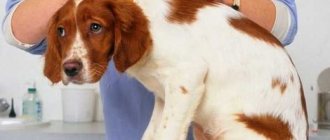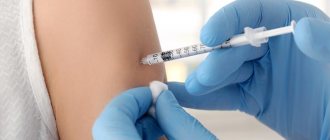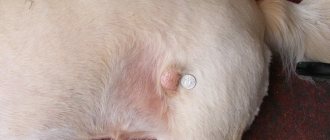Oncological tumor of the breast
Having discovered a tumor on the abdomen of an animal, the most dangerous cause – mammary gland cancer – should be excluded from the very beginning. Unfortunately, it occurs quite often in cats, as in people. The diagnosis is very scary. If the disease is detected late, its prognosis is unfavorable. The animal dies.
© shutterstock
Bumps with breast cancer appear on the belly in the area of the nipples. Most often the swelling is single, but there are also multiple formations. Sizes vary. The bigger the lump, the worse the situation. If seals appear on other parts of the body (for example, on the neck or limbs), then everything has gone very far - the animal’s body is affected by metastases.
A cancerous tumor in cats on the abdomen is characterized by the following features:
- hard to the touch;
- hot;
- grows quickly;
- in most cases – mobile;
- in the initial stages, the skin over the bump is of normal color, and in the later stages it turns red or purple;
- with advanced cancer, the lump bleeds.
It is quite difficult to detect oncological lesions of the mammary glands in a cat at the initial stage. The animal behaves as usual, eats normally, plays. Pronounced changes in behavior appear later, when the disease is advanced. In order not to let this happen and not lose your pet, you need to constantly examine it and show it to a specialist at least once a year. If you find a lump, be sure to take your cat to the vet.
Cancer at an early stage can be cured. In such cases, surgery is performed. The prognosis largely depends on the age of the animal, the general condition of its body, the skill of the surgeon and the quality of care of the owners. At later stages, specialists no longer undertake to treat cats with oncology.
Treatment depending on the cause of the appearance of the ball under the skin
If a neoplasm is noticed in an animal, it is necessary to contact a veterinarian. The tumors are removed; no ointments can help with their treatment. If the lump is due to suppuration, it is opened and washed with a disinfectant solution.
When a hernia appears, it is removed with massage or a tight bandage. In extreme cases, surgical removal is resorted to.
Lipoma is rarely removed; in most cases it is treated with ointments and other medications.
Mastitis responds well to treatment with compresses and antibiotics. Sometimes massage is used. For mastitis, a novocaine blockade, physiotherapy, and, in extreme and advanced cases, surgery are also often prescribed.
Cancerous formations are treated with chemotherapy, and then surgery is performed with further removal. It is important to pay attention to whether metastases have occurred, so as not to waste time and take the right treatment tactics.
As for benign formations, if they are small in size and do not bother the animal, surgical intervention is not required. When a soft lump appears on a kitten’s stomach, as a rule, this is a benign neoplasm; conservative treatment methods are most often prescribed.
Benign tumors can be treated with medications
Subcutaneous tumors, such as abscesses and cysts, are treated conservatively, but they cannot be neglected. The specialist washes and treats the area with furatsilin and hydrogen peroxide. In the most difficult cases, additional antibiotics are prescribed. At home, it is better not to squeeze pus out of wounds, as it can enter the bloodstream, and, as a result, blood poisoning or a recurrent abscess will begin. Moreover, there is no need to wait for the abscess to open on its own.
Cysts can form due to clogging of the glands, they can be filled with sebum-like contents, and they can be follicular.
For lymphadenitis, the cat is prescribed medications that eliminate inflammation in the lymph nodes.
For infectious bumps, antibiotics and anti-inflammatory drugs are prescribed.
In case of allergies, the cause is determined, antihistamines are prescribed and the factor that provoked the reaction is eliminated.
If a decision has been made to undergo surgery, then after the operation the animal is prescribed a course of antibiotic therapy, immunomodulators, and if we are talking about a malignant tumor, then a course of chemotherapy.
Lipoma
A lump on a cat's stomach may be a common lipoma (subcutaneous fat). This is also a tumor, only benign. She is not life-threatening. Features of lipoma bumps :
- round form;
- quite large sizes;
- soft consistency;
- does not grow rapidly;
- mobile (moves under the skin when pressed, glides easily).
A tumor on the abdomen can cause discomfort to the cat: it itches or interferes with movement. Especially if it is large. In such cases, the lipoma is removed surgically. If the lump is relatively small and does not bother the cat, they try not to touch it.
© shutterstock
However, before you calm down, you should make sure that it is a lipoma. It is imperative to show the animal to a veterinarian and undergo an examination to rule out more serious diseases.
What to do if the lump is bleeding or discharges pus
If the cat owner notices that the tumor has begun to bleed or that pus is oozing from it, then this is a very dangerous symptom that indicates a malignant formation.
Note! Sometimes a cat's lump under the skin on its abdomen can also be an abscess, which can rupture on its own. It is highly undesirable to wait for this, as the pet will experience pain and suffering. Even after septic treatment, pus may still be released for some time, so the wound must be treated and washed.
Very often, cats develop bumps that frighten their owners. The percentage that they are malignant is quite low, so if a neoplasm is detected, you need to take your pet to the doctor’s clinic as quickly as possible for a medical examination and to rule out the worst cases of the disease.
Lumps may form on your cat's belly. Some formations do not harm the health of the pet, while others pose a threat to life. Let's consider the types of swellings and bumps that form on the abdomen and the causes of their occurrence. Options for action when a pathological focus is detected are given.
Skin pathologies
A lump on a cat's stomach may be one of the skin diseases that are divided into benign and malignant. The first group of ailments includes :
- Boils are inflammatory processes in the hair follicle. The lump is small and painful at first. Over time, it increases to 1-1.5 cm due to the accumulation of pus. At the final stage it is opened. Pus flows out.
- Folliculitis is an inflammatory lump with pus. It is a small nodule on the abdomen. It develops due to ingrown hairs, the skin around which turns red and swollen.
- A carbuncle is a lump covered with multiple blisters containing purulent fluid.
- An abscess is an inflammation resulting from a bacterial infection that has gotten under the skin. Pus accumulates in a limited cavity. Spread of infection to adjacent areas is rare. Sometimes it does end up in the blood or lymph. An abscess lump is usually painful. Often accompanied by an increase in temperature.
- Phlegmon is a diffuse purulent inflammation. The lump is very painful. The skin over it is red.
Treatment of benign neoplasms on a cat's abdomen is usually conservative. Therapy includes ointments, creams and other similar products for external use. Surgery is very rarely required.
Malignant lumps on a cat's abdomen grow rapidly. They are dense, covered with bumps and ulcers. Skin necrosis is observed in some areas of the tumor. The seals are movable. Treatment is surgical. The prognosis depends on the stage.
Analysis of possible reasons
Before you assume the worst, you need to rule out a lot of possibilities. A lump in your cat's groin could be a common manifestation of an allergic reaction to food, flea dermatitis, or an insect bite. Associated symptoms such as redness and severe itching are of great importance. Hard, bleeding lumps are most often of malignant origin. But the option of tumor processes can be confirmed or excluded only after examination by an oncologist and a series of diagnostic measures. The following possible causes of the disease will also be considered without fail:
Insect bites. This will surprise many, but red bumps in a cat's groin may well be the result of flea bites. In some pets, lumps after parasite bites can reach the size of a hazelnut. Much attention is paid to the presence of redness, peeling and swelling of the skin at the location of the lesions. Itching can lead to deep scratches that are left behind by your pet's claws. Even a cat that never leaves the house can get fleas, so regular antiparasitic treatments should not be ignored, especially during the active season. For this, drops can be used on the withers (Frontline, Stronghold, Bars, Advantage), which guarantee protection for 30 days.- Ixodid tick. During the active season, if the cat is often outside, it can also cause a hard lump to appear in the groin area. The tick itself may not be detected; it drinks blood and falls off, or the pet discards it itself. But after its bites, hard nodules almost always remain, around which there is a red rim. If the parasite still remains on the animal’s body, then it should be carefully removed using tweezers or special veterinary pincers (they are sold in every pharmacy, are inexpensive, and pay for themselves 100% if there is also a dog in the house). The location of the bite is required
treated with an antiseptic. There are cases when it is not possible to completely remove the tick; the head comes off and remains under the skin. This can cause an abscess to form, so in such situations it is better to take your pet to the veterinarian. - Abscess. It can also cause a soft lump to appear in your cat's groin. The appearance of an abscess can be caused by a bacterial infection, inflammation of the hair follicle, an ixodid tick bite, or a foreign body entering the skin. Even a bite from teeth or a scratch from claws can cause an abscess to form on the animal’s body. At first it may look like a small pimple, but over time it becomes the size of a pea. Always accompanied by redness and swelling of the skin. There is severe pain even at rest. If the abscess is localized in the groin area, the animal may experience severe pain while moving. Many abscesses burst on their own, so it is important not to miss this moment, since it is necessary to immediately treat the wound with an antiseptic solution. You can also make a compress based on levomekol on this place. In difficult cases, the abscess is opened surgically. During the operation, all pus is removed from the wound, and the lesion is drained.
Injury. One of the most common causes of small bumps in the groin area in cats. A hematoma can form after a fall from a height, a fight, or a collision with hard surfaces. Hematomas can reach large sizes, their color ranges from dark blue to black. Accompanied by pain. If there are no open wounds and the possibility of a limb fracture is excluded, then even large bruises disappear without a trace within 1-2 weeks. The pet must be shown to the veterinarian in cases after a fall from a great height or an accident.- Education. The most unpleasant thing that can happen is when you feel a lump the size of a nut on a cat. In individuals under 5 years of age, in most cases, such neoplasms are of a benign nature (wen, mastitis, cryptorchidism). But the older the animal, the greater the risk of developing malignant tumors, a significant proportion of which occur in the groin area. Here you can’t do without a biopsy, histological examination, ultrasound of the abdominal cavity and radiography. Timely removal of malignant neoplasms in the absence of metastases allows us to count on a significant extension of the animal’s life. Surgery can be refused only in case of heart or kidney problems (they will not allow you to endure anesthesia). Then palliative therapy is indicated.
Remember that any lump in a cat’s groin should be examined by a veterinarian, as there is always a risk of developing malignant tumors, which, if detected at an early stage, can save your pet’s life.
The appearance of cones in cats is a common phenomenon. Every owner should know that they grow very quickly, and many are even life-threatening. Most of the bumps appear on the animal's tummy. After the initial detection, the owner should not hesitate and quickly consult a doctor, as the animal’s condition may worsen.
Lymphadenitis in cats
A lump may appear on a cat's stomach if the inguinal lymph node becomes inflamed. The cause is an infection leading to diseases of the genitourinary system. With lymphadenitis, compaction is characterized by the following features :
- oblong shape;
- soreness;
- immobility;
- the skin over the bump is hot.
If such a tumor is discovered, the cat should definitely be shown to the doctor. The disease that causes lymphadenitis requires treatment. Antibiotics, anti-inflammatory drugs, preparations with vitamins, iron, magnesium, potassium and other beneficial substances that help strengthen the immune system may be indicated.
Symptoms of lymph node inflammation are similar to cancer. Cancer can only be ruled out by diagnostics, so a trip to the clinic is essential.
Hernia
If a cat has a lump under the skin on its stomach, this may indicate a hernia, which is localized in the groin. The formation comes in different sizes - from tiny to 5-6 cm. Sometimes it is located in one place, and sometimes it “migrates” within the groin. In this case, the lump can behave differently.
© shutterstock
In some cases, hernial tumors are very painful, while in others they do not bring any discomfort to the pet at all. The temperature of the skin over the lump may increase greatly or remain normal. The tumor itself can be hard or soft.
In any case, a hernia is serious. Therefore, the cat needs to be examined by a veterinarian and treated, which is often surgical. If the hernia is small and does not bother you, conservative measures are used. Massage, special fixing bandages, etc. are prescribed. A dangerous complication of a hernia is its strangulation. It leads to inflammatory processes in surrounding tissues.
Mastitis
If a lump is found on a female's belly, it may be mastitis. Most often it develops in cases where kittens are taken away from their nursing mother too early. The cat suffers greatly from stagnant processes. Her mammary glands are very sore, her body temperature reaches high levels, the animal loses appetite and sleep, and quickly becomes exhausted.
Mastitis bumps are red. They are very hard to the touch and hot. Located near the nipples. When pressed they increase in size. Sometimes milk with purulent impurities is discharged from the nipples. In other cases it disappears completely.
Mastitis does not always occur after childbirth. It can result from mechanical damage to the nipples, false pregnancy, or some gynecological pathologies. Requires veterinary assistance. Treatment depends on the form and extent of the disease. In uncomplicated situations, you can get by with ointments and compresses; in severe situations, you have to resort to radical measures.











